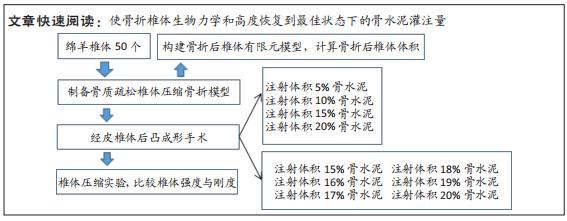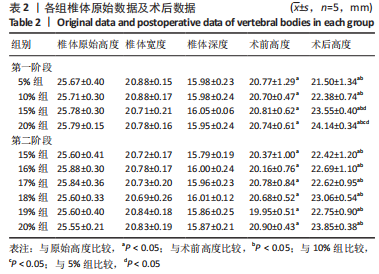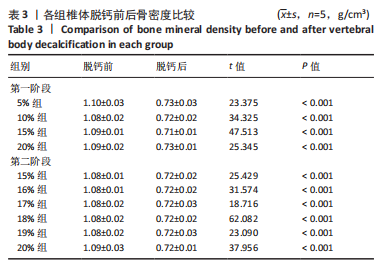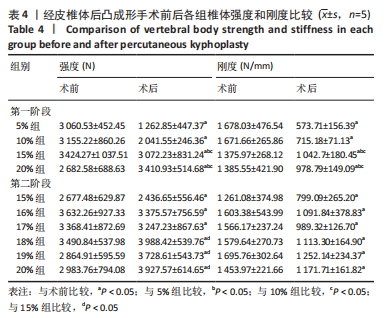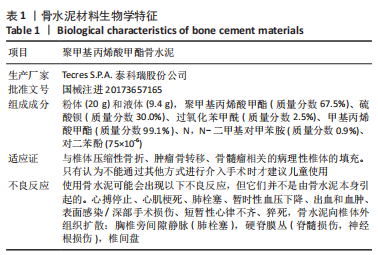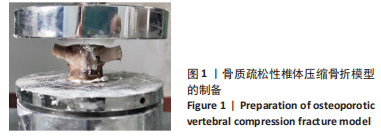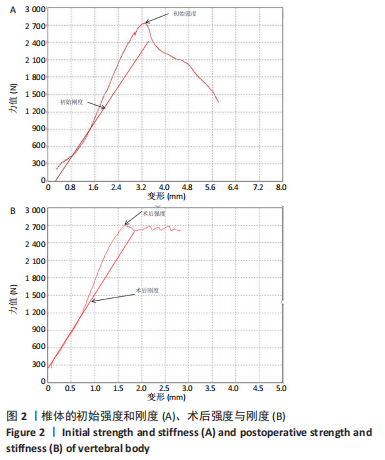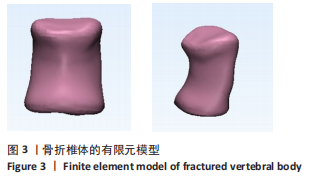[1] 原发性骨质疏松症诊疗指南(2017)[J].中华骨质疏松和骨矿盐疾病杂志,2017,10(5):413-444.
[2] LI WS, CAI YF, CONG L. The Effect of Vertebral Augmentation Procedure on Painful OVCFs: A Meta-Analysis of Randomized Controlled Trials. Global Spine J. 2022;12(3):515-525.
[3] TSOUMAKIDOU G, TOO CW, KOCH G, et al. CIRSE Guidelines on Percutaneous Vertebral Augmentation. Cardiovasc Intervent Radiol. 2017;40(3):331-342.
[4] SHAH LM, JENNINGS JW, KIRSCH CFE, et al. ACR Appropriateness Criteria Management of Vertebral Compression Fractures. J Am Coll Radiol. 2018;15(11S):S347-S364.
[5] KAUFMANN TJ, TROUT AT, KALLMES DF. The effects of cement volume on clinical outcomes of percutaneous vertebroplasty. AJNR Am J Neuroradiol. 2006;27(9):1933-1937.
[6] 姜亮,柳达,邱敏,等.PVP和PKP术中骨水泥用量与分布对预后影响的研究进展[J].颈腰痛杂志,2022,43(1):124-126.
[7] 毕航川,段浩,王均,等.骨质疏松性椎体压缩骨折椎体强化术后骨水泥血管渗漏的危险因素分析[J].中华创伤杂志,2022,38(4):307-313.
[8] Li YX, Guo DQ, Zhang SC, et al. Risk factor analysis for re-collapse of cemented vertebrae after percutaneous vertebroplasty (PVP) or percutaneous kyphoplasty (PKP). Int Orthop. 2018;42(9):2131-2139.
[9] SUN HB, JING XS, TANG H, et al. Clinical and radiological subsequent fractures after vertebral augmentation for treating osteoporotic vertebral compression fractures: a meta-analysis. Eur Spine J. 2020; 29(10):2576-2590.
[10] KALLMES DF, COMSTOCK BA, HEAGERTY PJ, et al. A randomized trial of vertebroplasty for osteoporotic spinal fractures. N Engl J Med. 2009; 361(6):569-579.
[11] BUCHBINDER R, OSBORNE RH, EBELING P, et al. A randomized trial of vertebroplasty for painful osteoporotic vertebral fractures. N Engl J Med. 2009;361:557-568.
[12] 金志鑫.骨质疏松椎体压缩骨折不同骨水泥灌注量的有限元分析[D].呼和浩特:内蒙古医科大学,2021.
[13] JIN YJ, YOON SH, PARK KW, et al. The volumetric analysis of cement in vertebroplasty: relationship with clinical outcome and complications. Spine (Phila Pa 1976). 2011;36(12):E761-772.
[14] NIEUWENHUIJSE MJ, BOLLEN L, VAN ERKEL AR, et al. Optimal intravertebral cement volume in percutaneous vertebroplasty for painful osteoporotic vertebral compression fractures. Spine (Phila Pa 1976). 2012;37(20):1747-1755.
[15] 李军科.椎体成形术中最小骨水泥注入大量的研究[D].石家庄:河北医科大学,2016.
[16] 孔垂永.骨脱钙实验中的稀盐酸[J].生物学教学,2000(10):24.
[17] 崔轶,雷伟,吴子祥,等.绵羊椎体骨质疏松性生物力学模型的快速建立[J].中国骨质疏松杂志,2010,16(1):13-18.
[18] 李贺.离体骨骨流失的模拟及防治方法研究[D].北京:中国科学院大学(中国科学院近代物理研究所),2018.
[19] 崔轶,吴子祥,刘达,等.骨质疏松性椎体脱矿化生物力学模型的研究进展[J].中国骨质疏松杂志,2011,17(3):259-263.
[20] BELKOFF SM, MATHIS JM, JASPER LE, et al. The biomechanics of vertebroplasty. The effect of cement volume on mechanical behavior. Spine (Phila Pa 1976). 2001;26(14):1537-1541.
[21] ERIKSSON SA, ISBERG BO, LINDGREN JU. Prediction of vertebral strengthby dual photon absorptiometry and quantitative computed tomography. Calcif Tissue Int. 1989;44(4):243-250.
[22] 崔伟,刘成林.基础骨生物力学(一)[J].中国骨质疏松杂志,1997(4):82-85.
[23] 文毅,苏峰,刘肃,等.L4-5椎体有限元模型建立及退变椎间盘力学分析[J].中国组织工程研究,2019,23(8):1222-1227.
[24] BELKOFF SM, MATHIS JM, DERAMOND H, et al. An ex vivo biomechanical evaluation of a hydroxyapatite cement for use with kyphoplasty. AJNR Am J Neuroradiol. 2001;22(6):1212-1216.
[25] 刘凯.低温冷却法延长经皮椎体成形术中骨水泥可注射工作期的实验研究[D].苏州:苏州大学.2016.
[26] DENIS F. The three column spine and its significance in the classification of acute thoracolumbar spinal injuries. Spine (Phila Pa 1976). 1983;8(8): 817-831.
[27] KELLER TS, HARRISON DE, COLLOCA CJ, et al. Prediction of osteoporotic spinal deformity. Spine (Phila Pa 1976). 2003;28(5):455-462.
[28] 张保良,陈仲强.骨质疏松性椎体压缩骨折分型及分级系统研究进展[J].中国骨质疏松杂志,2021,27(4):590-594.
[29] 刘念,李志安,李振武,等.骨质疏松椎体压缩骨折保守治疗后不愈合的危险因素[J].中国矫形外科杂志,2020,28(22):2065-2068.
[30] 刘志强,雷飞,周云龙,等.骨质疏松性椎体压缩性骨折研究进展[J].国际骨科学杂志,2020,41(2):90-94.
[31] LONG Y, YI W, YANG D. Advances in Vertebral Augmentation Systems for Osteoporotic Vertebral Compression Fractures. Pain Res Manag. 2020; 2020:3947368.
[32] WEI H, DONG C, ZHU Y, et al. Analysis of two minimally invasive procedures for osteoporotic vertebral compression fractures with intravertebral cleft: a systematic review and meta-analysis. J Orthop Surg Res. 2020;15(1):401.
[33] MOLLOY S, MATHIS JM, BELKOFF SM. The effect of vertebral body percentage fill on mechanical behavior during percutaneous vertebroplasty. Spine (Phila Pa 1976). 2003;28(14):1549-1554.
[34] LIEBSCHNER MA, ROSENBERG WS, KEAVENY TM. Effects of bone cement volume and distribution on vertebral stiffness after vertebroplasty. Spine (Phila Pa 1976). 2001;26(14):1547-1554.
[35] ROTTER R, SCHMITT L, GIERER P, et al. Minimum cement volume required in vertebral body augmentation--A biomechanical study comparing the permanent SpineJack device and balloon kyphoplasty in traumatic fracture. Clin Biomech (Bristol, Avon). 2015;30(7):720-725.
[36] BELKOFF SM, MARONEY M, ENTON DC, et al. An in vitro biomechanical evaluation of bone cements used in percutaneous vertebroplasty. Bone. 1999;25(2 Suppl):23-26.
[37] HANSSON T, KELLER T, JONSON R. Fatigue fracture morphology in human lumbar motion segments. J Spinal Disord. 1988;1(1):33-38.
[38] BRINCKMANN P, JOHANNLEWELING N, HILWEG D, et al. Fatigue fracture of human lumbar vertebrae. Clin Biomech (Bristol, Avon). 1987;2(2):94-96.
|
